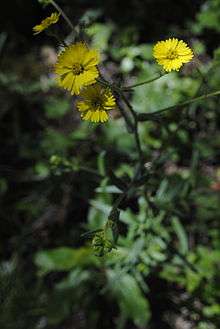Anisocarpus madioides
| Anisocarpus madioides | |
|---|---|
 | |
| Nature Reserve, University of California, Santa Cruz | |
| Scientific classification | |
| Kingdom: | Plantae |
| (unranked): | Angiosperms |
| (unranked): | Eudicots |
| (unranked): | Asterids |
| Order: | Asterales |
| Family: | Asteraceae |
| Genus: | Anisocarpus |
| Species: | A. madioides |
| Binomial name | |
| Anisocarpus madioides Nutt. | |
| Synonyms[1] | |
|
Madia madioides (Nutt.) Greene | |
Anisocarpus madioides (syn. Madia madioides) is a North American species of flowering plant in the aster family known by the common name woodland madia.[2]
Range
Anisocarpus madioides is native to the west coast of North America on Vancouver Island in the Canadian Province of British Columbia and in the US States of Washington, Oregon, and California. It is a plant of forest and woodland habitat. Most of the populations occur in the Cascades and in the Coast Ranges from Vancouver Island to San Luis Obispo County, but there are additional collections from the foothills of the northern Sierra Nevada and from the Agua Tibia Mountains of San Diego County.[3][2]
Description
Anisocarpus madioides is a perennial herb growing up to about 75 centimeters in height, its stem coated in rough hairs and stalked resin glands. The lower leaves are up to 12 centimeters long, oppositely arranged, and fused around the stem at the bases. The upper leaves are much smaller and often alternately arranged. The inflorescence produces several flower heads on long peduncles, each with a rounded involucre of glandular phyllaries. The heads bear yellow ray florets up to a centimeter long and many disc florets. The fruit is an achene a few millimeters long, usually with a small pappus.[4]
References
External links
- Calflora Database: Anisocarpus madioides (Woodland madia)
- Jepson Manual eFlora (TJM2) treatment of Anisocarpus madioides
- United States Department of Agriculture Plants Profile
- UC Calphotos Photo gallery of Madia madioides